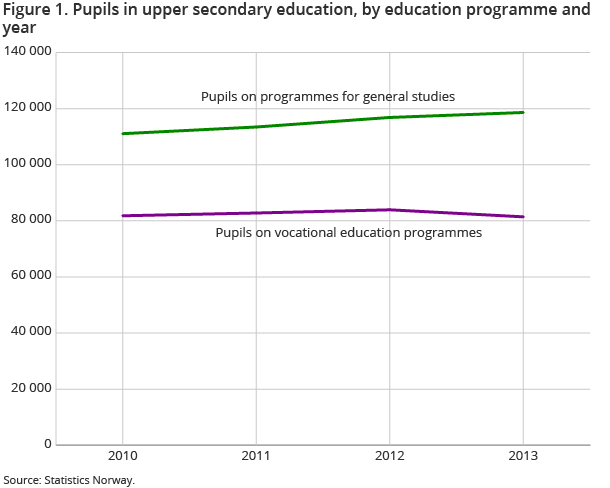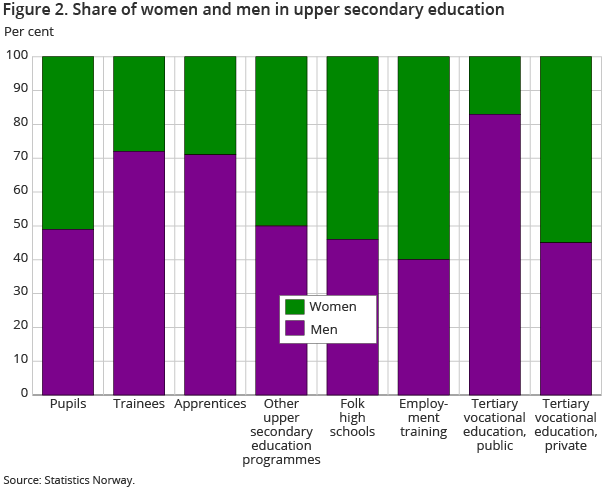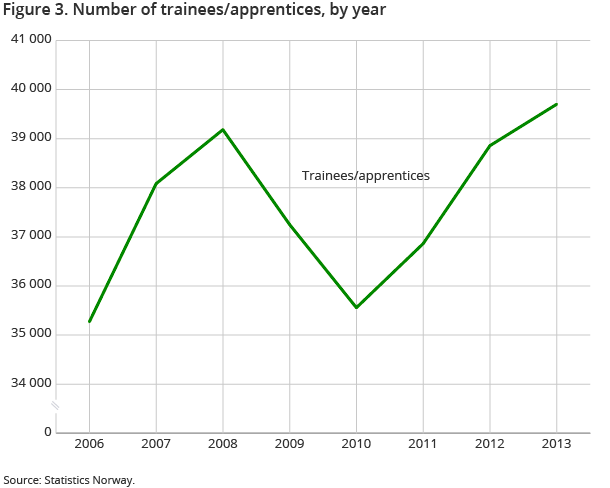Content
Published:
This is an archived release.
Steady increase of pupils on programmes for general studies
The number of pupils on programmes for general studies has increased continuously in recent years. There is also a small decrease in the number of pupils on vocational education programmes in 2013 compared to previous years.
| 2013 | 2012 - 2013 | 2009 - 2013 | |
|---|---|---|---|
| Change in per cent | |||
| Pupils | 200 056 | 0 | 5 |
| Apprentices and trainees | 39 702 | 2 | 7 |
| Pupils and apprentices and trainees | 239 758 | 0 | 5 |
| Which | |||
| Immigrants | 22 300 | 10 | 52 |
| Norwegian-born | 9 057 | 3 | 29 |



In total, there were 200 056 pupils in upper secondary education in 2013. Almost 60 per cent of these pupils attended programmes for general studies , while the remainder attended vocational education programmes . The education programme with the highest number of pupils is 'specialisation in general studies'. About 57 per cent of the pupils on this programme were women.
The highest number of pupils on the vocational education programmes attended 'health and social care' (with 85 per cent women) and 'technical and industrial production' (with 90 per cent men). 'Restaurant and food' was the education programme with the most even gender distribution, where 51 per cent of the pupils were men.
Eighty-five per cent of the pupils in upper secondary education were aged 16-18, and 14 per cent had an immigration background .
In total, there were 56 000 pupils registered on the final year of upper secondary school. Seventy-two per cent of the men and 79 per cent of the women completed their education. The highest pass rate was in 'music, dance and drama', while 'electricity and electronics' had the lowest pass rate with 68 per cent.
More women than men in upper secondary education
In total, there were 272 437 participants in upper secondary education in 2013, and 53 per cent of them were men. Figure 2 shows that the share of men was particularly high among the apprentices, the trainees and the students in public tertiary vocational education. At the same time, the women are in the majority in private tertiary vocational education, folk high schools and employment training.
Increasing number of trainees and apprentices
The total number of apprentices and trainees was 38 000 and 1 750 in 2013 respectively. Figure 3 shows the development in the number of trainees/apprentices, and that it has increased by 2 500 since 2010.
Women constitute 28 per cent of the trainees/apprentices and eight per cent had an immigration background. Incidentally, among the trainees/apprentices with an immigration background, 38 per cent are women. The gender distribution is, in other words, more evenly spread among those with an immigration background than for the rest of the population.
Increasing number of apprentices take vocational examinations
A total of 23 500 vocational examinations were held in 2013 and there were almost twice as many men than women that took the exam. Among the apprentices, there was an increase of 800 vocational examinations since the previous year, whilst among the trainees there was a decrease of 600.
As of the previous year, 91 per cent of both the men and the women passed the examination. The highest pass rate was in 'technical and industrial production' and 'media and communication' with 94 per cent, whereas 'design, arts and crafts' had the lowest pass rate with 84 per cent.
More students at private tertiary vocational schools
As of autumn 2013, there was almost 16 000 students in tertiary vocational education. Fifty-seven per cent of the students attended private schools and 38 per cent were women.
The number of students in private tertiary vocational schools has increased by 3 400 since 2011. The majority of the students at private schools were women – 54 per cent, and the special fields with the highest number of women were 'humanities and arts' and 'business and administration'. The majority of women in public tertiary vocational schools attended 'health, welfare and sports'.
Eighty-three per cent of the students in public tertiary vocational schools were men, and the special field with the absolute highest number of men is 'natural sciences, vocational and technical subjects'.
Slight fall in pupils at folk high schools
As of 1 October 2013, there were about 6 700 pupils in folk high schools, of which 55 per cent were women. Since 2011, there has been a decrease of 500 pupils at the folk high schools.
In total, 94 per cent of the pupils in folk high schools completed the 2013 school year. The lowest completion rate was among pupils younger than the age of 19, where 85 per cent completed. However, this group of pupils only constituted nine per cent of the total number of pupils. The 19 year-olds constituted over 60 per cent of the pupils and 96 per cent of them completed the school year.
Contact
-
Daniel Instebø
E-mail: daniel.instebo@ssb.no
tel.: (+47) 45 12 72 66
-
Anna-Lena Keute
E-mail: anna.keute@ssb.no
tel.: (+47) 95 44 30 88
